Bold colors, crisp geometric shapes, and animals of all kinds…who can resist? The artwork of Will Eskridge caught my eye right away. His use of color is spot on and his work explores the fluid relationship between nature and technology – with a focus on animals. Originally from Kings Mountain, North Carolina, Will Eskridge attended the University of North Carolina School of the Arts, School of Visual Arts/Savannah and earned his B.F.A. in Interdisciplinary Arts from San Francisco Art Institute in 1999. With a father as a veterinarian and an artist mother, his affinity for animals and art began immediately. Eskridge constantly explores a wide range of mediums, including film and mixed media, but his true love is oil painting. Eskridge’s work has been exhibited nationally and collected internationally. He now works as a full-time artist and resides in Athens, GA with his wife and their many dogs and cats. Along with art, Will also plays drums, helps in animal rescue and has an ongoing restoration of his beloved 1953 Buick. But how did he get to where he is now? Let’s take a deeper look into Eskridge’s artwork, his past, his present, and ultimately, his future…
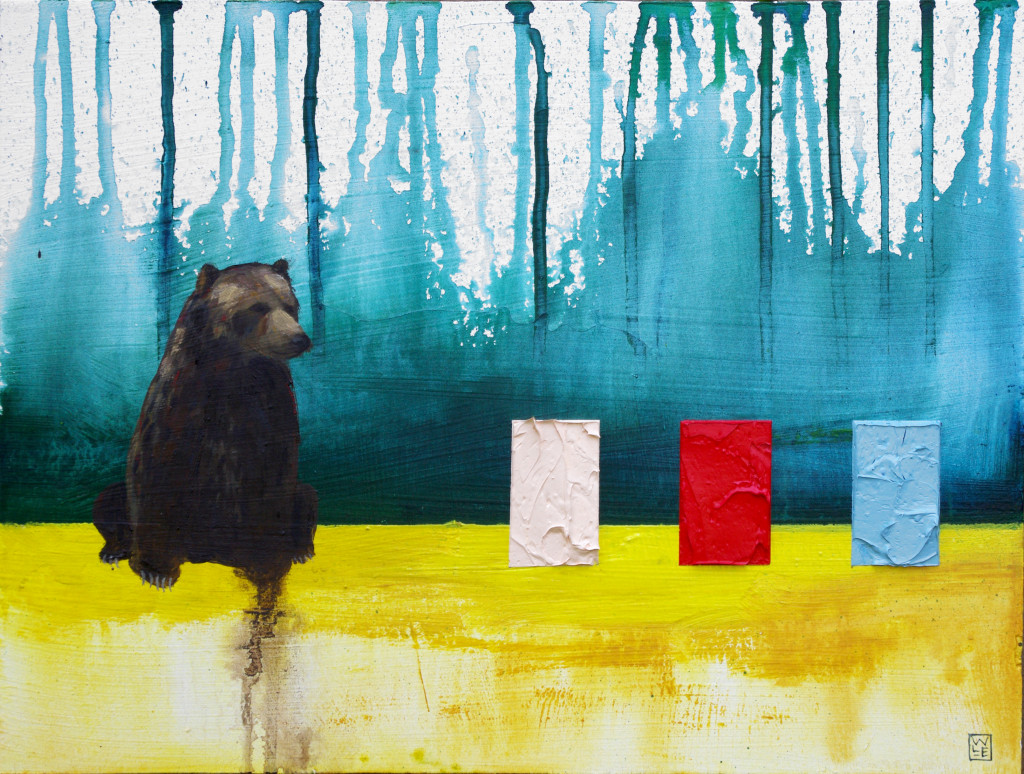
THE BEGINNING…
Emily Frankoski: Where are you from originally and where do you now reside? How did you get “from here-to-there?”
Will Eskridge: I was born and raised in Kings Mountain, North Carolina. My dad is a veterinarian and my mom is an artist and musician. They have always been very supportive of my artistic endeavors. I attended the University of North Carolina School of the Arts in Winston-Salem, NC – a magnet high-school for visual arts, drama, music, dance and filmmaking. It was an amazing experience. I was introduced to many walks of life. The school really opened my eyes and mind to possibilities out in the world. This sparked the nomadic itch I was scratching in my 20’s. After graduating high school, I attended School of Visual Arts in Savannah, GA and then to San Francisco Art Institute where I earned my B.F.A. in Interdisciplinary Arts in 1999. After graduation, I was not sure what I was going to do to make ends meet. San Francisco isn’t cheap and I was missing North Carolina, so I decided to move back and accepted a job as a graphic designer at the Cleveland County Arts Council. After a year and a half, I moved down to Charleston, SC briefly where I met some great artists and played in a few bands. I squeezed in painting whenever I could. Several years later, I relocated to Nashville, TN with one of my best friends to start another band and spend time with my brother. Again, I painted when I could and did some illustration work here and there. In 2006, I finally had my fill of Nashville and decided to move to Athens, GA where I didn’t know anyone. I bought a small house with a little bit of land, a studio in 2008, met my future wife in 2010… and decided to stay.
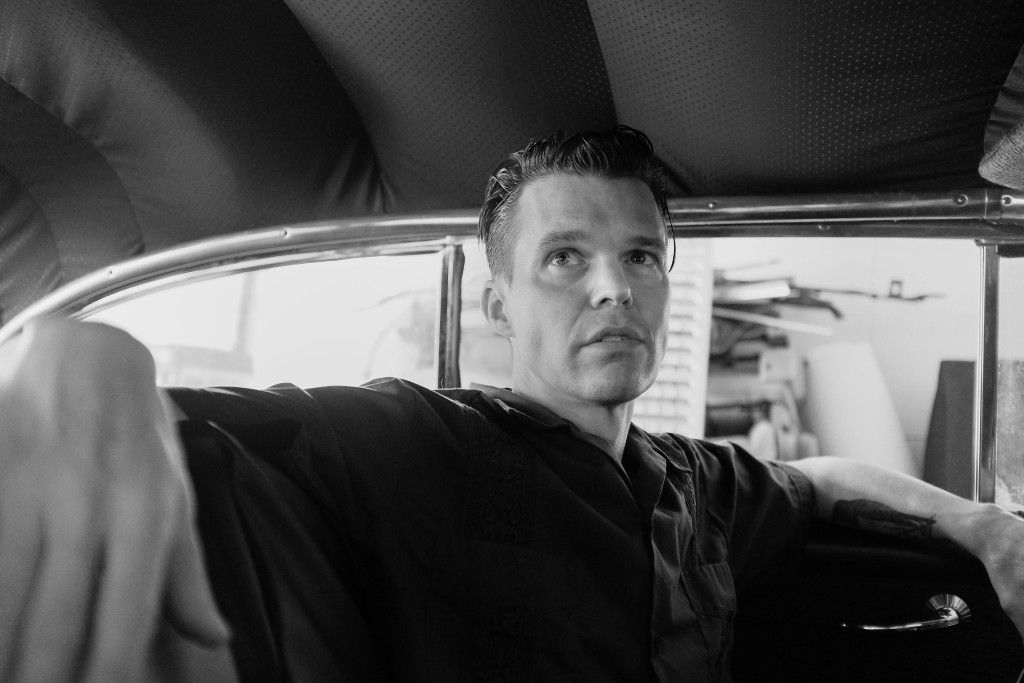
Photo of Will Eskridge by Sean Dun
EF: What did you want to be when you grew up? How does that compare to what you are living out in your adult life? Has your journey been linear or non-linear?
WE: I never wanted to be anything other than an artist. At 10, 15 seems old; when you are 20, 30 seems old, and so on. I just turned 39 and recently took a leap into full-time artist. Overall, my adult life is pretty much how I envisioned it as an artist. I don’t think it is as glamorous as I had pictured it when I was 6 or 7 years old and that is quite alright. My journey has been non-linear even though I knew I was to be an artist. Figuring out exactly what that meant has been challenging because I have many interests. I play music, primarily drums, and there were moments in my 20’s when I thought I was going to pursue music full-time. We had some great times, but at 29 or 30, I realized playing music was more of a hobby. Music draws my passion, but I don’t have the drive for it like I do for visual art. I also co-founded a film festival in my hometown, that is still going 16 years later. I have toured the U.S. with one of my bands and worked a myriad of odd jobs including natural pet food clerk, handyman, home–theatre installer and bar bouncer. I did all of this while making art whenever and however I could. In middle school, I designed table lamps, painted landscapes, drew comic book characters and made claymation films…anything I could do to make art. I never wanted to teach so the academic sector was out for me. After college, I was scared. In my mind at that time, teaching was the only way to make a living as an artist. Since I didn’t want to teach, I fell into graphic design and started out doing newsletters and pamphlets. I progressed to band flyers, websites, logo creation and worked as a pre-press technician/graphic designer for various print shops. I appreciate graphic design, certainly, but it was never my passion like painting, drawing or sculpting is to me. Graphic design wore me down creatively. I used up my creative brain all day on graphic design to the point where I didn’t have much leftover for my own endeavors. I still had ideas for projects but I didn’t have the energy or time to move forward and expand. I got side-tracked. It has taken me a long time to realize this. I finally left the 9-6 life last December and have a new lease on life. I feel like I am just getting started with my art career. To be clear, I don’t regret those times. I met some wonderful people over the years that are still my friends… some of my best friends, actually. Knowing graphic design has allowed me to create and maintain my own website, make all my flyers for receptions, postcards and business cards…so it has been a good thing.
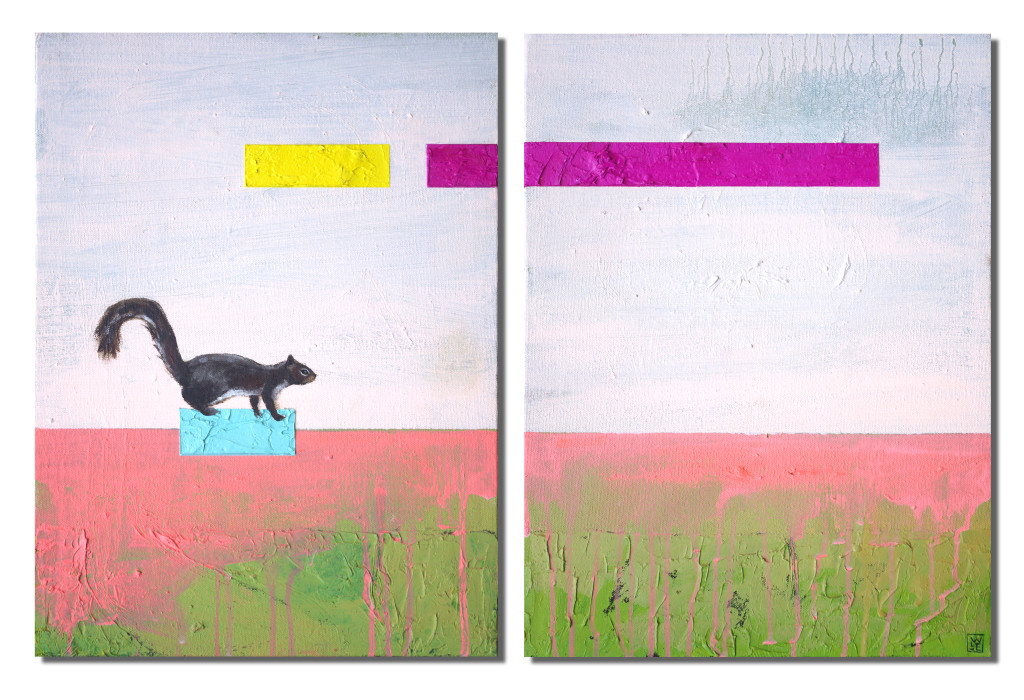
EF: If you haven’t done so in the previous answer, explain your general background? What were you like as a kid/what type of student were you/what did you spend your free time doing?
WE: My brother, sister and I were “outside” kids. We played our fair share of Atari and Nintendo, but it was only after we had finished our homework and been outside. I was an average student. I daydreamed a lot. My mind wandered endlessly, gazing outside. I’ve always loved the outdoors. My mom and dad took us on camping trips when we were younger and I was in cub and boy scouts in my pre-teens so that instilled an appreciation for nature. I remember going to farm-calls with my dad when he was doing large animal practice. I also have many memories of my brother and me hanging out with the neighbors behind us at “The Fort” between our backyards. We dug trenches, wrestled, climbed trees and made mini battle zones for our G.I. Joe action figures. We’d camp back there. We’d often play back there until Mom had to ring the dinner bell for us to come in, no joke! Dad used to take us target shooting at an impromptu shooting bank out in the woods where we’d plink at tin cans and shoot skeet. I’m not into guns but I know how to shoot and I earned a healthy respect for that technology. In my teens, I backpacked small parts of the Appalachian Trail with my grandparent’s church group. Skateboarding and playing the drums found me around the age of 12. My love of animals and nature most likely rubbed off from my dad and mom. I learned a conservation ethic from their actions. Growing up I watched my dad care for thousands of animals. My mom is a real mountain-woman who weaves, plays fiddle and has a log cabin in the backyard. They have always been very resourceful too; that kind of stuff sticks with you. I am thankful to have such loving and supportive parents.
EF: How did your relationship with art begin? What is your background in art (undergrad/and grad)?
WE: The first thing I remember was being in preschool and falling in love with finger paints. I continued to draw all through grade school, middle school and high school. My parents enrolled me in afternoon workshops and classes given by local professional artists, A.B. Snow, John Brady and Amber Tate. I first found out about the Visual Arts program at the University of North Carolina School of the Arts when I was a freshman in high school. The Visual Arts program at U.N.C.S.A. is a two-year high school program for juniors and seniors. Wanting to continue my education on the college level, I attended School of Visual Arts in Savannah and studied painting under the amazing painters, Patrick McCay and Jeff Markowsky. S.V.A. had started a small campus in Savannah during the mid 1990’s and that is the one I attended (not the original New York campus). A previously established art school in Savannah didn’t take kindly to S.V.A. encroaching on their territory, and basically booted them out…so I had to transfer again. There was a silver-lining since I transferred to San Francisco Art Institute and grew exponentially. I was exposed to so many alternatives. In one painting course, I met someone who would become one of my heroes, Julia Couzens. While I only had one semester with her, it was profound. She taught me so much about the abstractness and delicacy of painting, alternative techniques and approaches. She also politely gave me a nudge to take pride and care of my art by making my own canvas and wood panels. Her influence still resonates with me today. I also had the privilege of attending multiple filmmaking classes by the truly astounding, Lawrence Jordan. He was a close friend and assistant to Joseph Cornell. Jordan is an amazing human being and artist. His cut-out animation films are meticulously shot single frame on film. I think he uses 16mm exclusively. He’s also a box maker which influenced my “Moxes”.
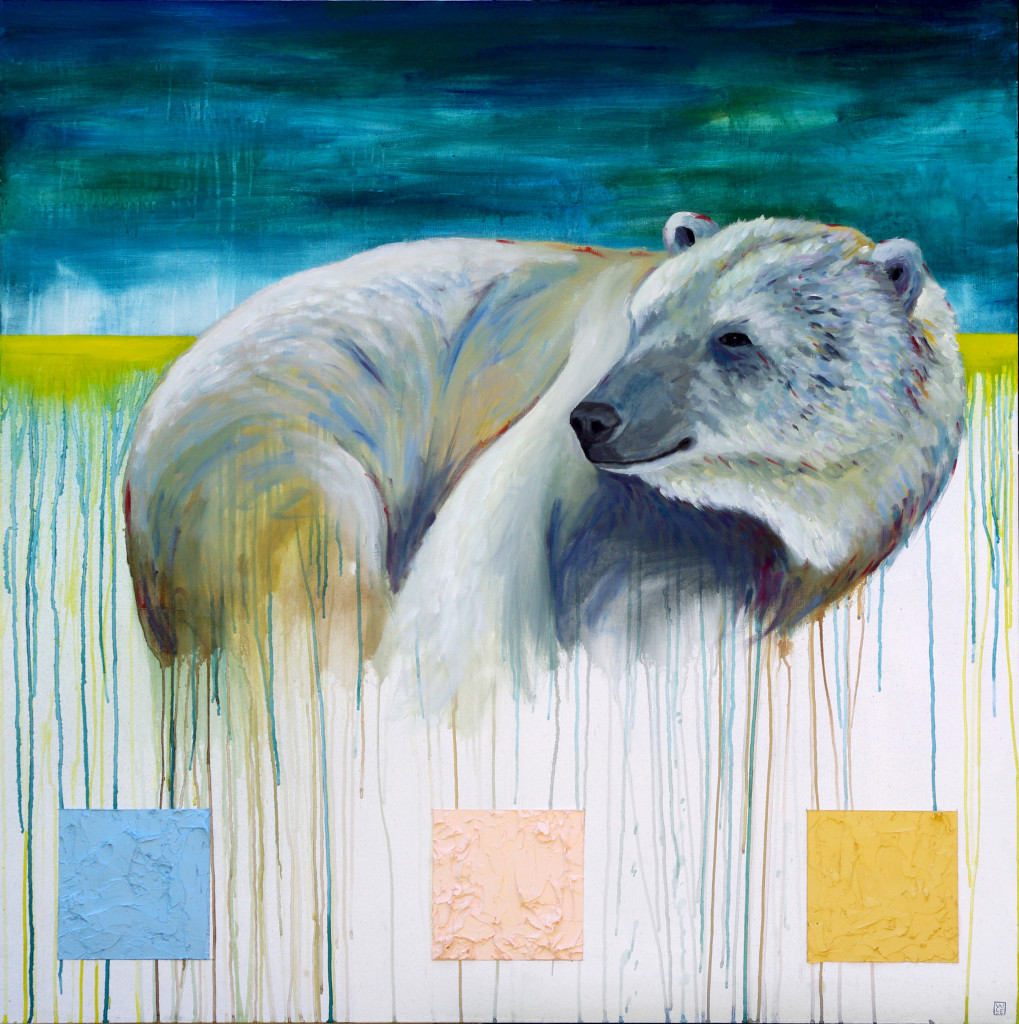
EF: Are their struggles to being an artist or has it always paid the bills?
WE: There are many. It’s a life of second guessing. Should I or shouldn’t I? My day can be full of life questions like: Am I really any good? Why did <insert gallery> reject me? Will I get into that juried exhibit? Does this painting make sense? Another major struggle is knowing when to pull away from my work. My wife is always telling me to take breaks. She has joked about putting a deadbolt on the studio with a sign that says, “GO TO THE MOVIES”. Getting away is important. Coming back with fresh eyes always improves the piece. It’s also good for the mind and soul to step away from art. Experience other things. My trail hikes are an excellent way for me to pull away and refresh my system. As for paying the bills, I’m having to get used to the ebb and flow of income. So far, for me it’s been famine or feast. I might make $1500 in one weekend at an art fair, but not sell anything at all for the next three weeks. There is income, it’s just not steady, so I have to buckle down and plan ahead. When I was working a job with a steady income, if I sold a painting it was like finding a bag of cash on the road. It was extra money. “Holy cow! Honey, we’re going out tonight!” Now it is my only source of income to pay the mortgage, electricity, gas, water, etc, so I’ve been taking on random art projects that still fit with my vision to make up the difference – tattoo designs, commissions and pet portraits – those sort of things.
EF: What would you call your prominent medium and how would you explain it to a novice?
WE: Oil Paint. It is a malleable paint made with ground pigment mixed with any one of a number of natural oils, most commonly linseed. It has a wonderful raw richness in color and texture that no other medium comes close to replicating. It technically never dries, only cures. It is my favorite medium.
EF: How would you describe your artwork in 4 words or less?
WE: Impressionistic surrealism.
EF: In your opinion, why is what you do important? Why do you create what you do?
WE: A lot of things in modern society are streamlined for better and for worse. I enjoy keeping one foot in the fast-paced world of today, and one foot in the slow lane of yesterday. It is important for the human race to progress and evolve while still learning from the past. We can learn so much from nature. I love reminders that cause me to slow down and contemplate, “How did this object get here?” I want to convey this engagement in my work and I think now, more than ever, we need to step a few paces back and look at the big picture instead of the instant gratification of progress.
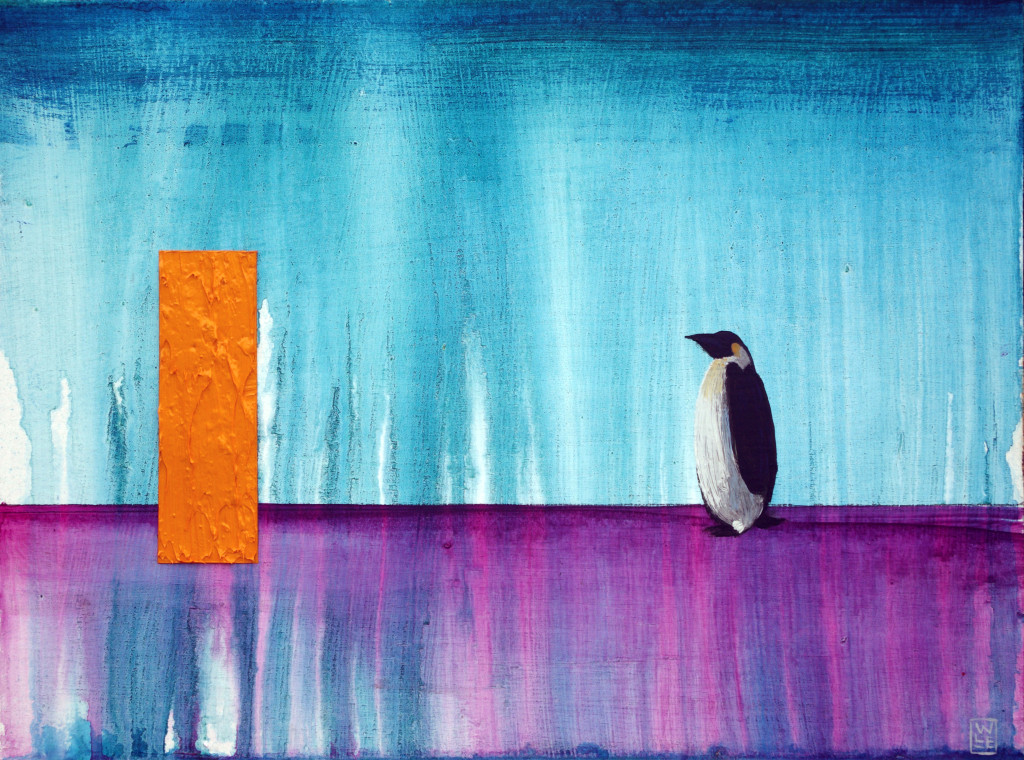
EF: If you weren’t an artist, what would you be and why?
WE: Wolf Biologist or Wildlife Veterinarian. It would be amazing to help animals directly.
CURRENT/FUTURE PROJECTS
EF: Tell us a little about your most recent body of work. What was the impetus for this project?
WE: The latest body of work is the “Environmental Habits” series. This ongoing body of work is a continuation of my depictions of animals confronted with hard geometric shapes. In this series, I simplified the composition a bit where it’s just a lone animal facing a single shape or very few shapes. I settled on the rectangle and square for the geometric shape as a basic representation of man-made structures as a whole: monoliths, skyscrapers, shipping containers… all representative of human innovation. For the main subject, I lean towards an endangered animal or animals of concern in an ecosystem. The work is meant to be slightly humorous on the surface, but with an underlying seriousness. The shapes are purposefully abrupt in the composition and many of the animals seem to be curious or confused by the hard-edged geometric object before them, as if thinking “What the hell is this and why is it here?” However, man is also a part of nature, so I want to ask “How can we coexist without decimating the land?” “How can we use our knowledge, compassion and advances in technology to add to the earth, rather than use it up?”
EF: Your website is fantastic! Could you briefly describe each section included in your “portfolio?” (especially moxes and wolf city!)?
WE: Ah, I’m glad you asked about the Moxes and “Wolf City”.
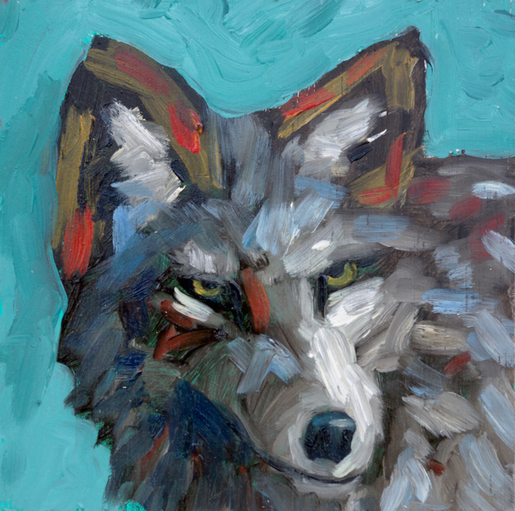 Wolf City: There is an annual art show here in Athens put together by the wonderful Michael Oliveri, Kristen Bach and Ted Kuhn. It’s called the Annual Bulldog Inn Art Show. They reserve all the rooms at this local seedy motel called The Bulldog Inn. An artist or band rents the room for one night and can do whatever they want as long as they leave the room exactly as they found it. It is a huge event and a crazy David Lynchian experience. I knew I wanted to do something I had never done before…something grand. I had the idea of turning one of my paintings into an oversized, three-dimensional space. At the time I had been painting a lot of wolves. I’ve been intrigued by the gray wolf for years. By about 1930, wolves were virtually removed through Federal and State predator eradication programs. After the fact, we realized they were apex predators, and a vital part of the ecosystem. So we started reintroducing them and eliminating removal programs from some states. After being hunted to near extinction, they were reintroduced into Yellowstone in the 1990’s. Today, there is still heated debate about their presence. Some people want them to run free. Some people want them to run free…just not in their backyard. Some people don’t want them at all…others could not care less. So my idea was a sarcastic, “Hey, we need a wolf city. A city where we can package and ship wolves wherever we want them and remove them from where we don’t want them. We’ll breed them and ship them out. It will be glorious!” I started sketching and came up with the idea to have an oversized sculpted wolf head as the focal point. Surrounding the giant head would be a surplus of stark white, nameless, shipping boxes all neatly stacked. On an adjacent wall I wanted to have a projection. The projection was a film-loop of a small wolf figurine that I cast in ice. I time-lapsed it melting in the sun. The loop was doing a yo-yo effect where it would melt and reform and melt again, over and over. On the opposite wall I had created a series of 12 small paintings of wolf heads. They were hung in a grid format and each was titled “Wolf City Resident 1, 2, 3, etc.” It was cohesive because I managed to find some nature recordings of wolves howling and growling along with some cricket sounds. The sounds were layered together and I looped it so it would play all night. I think the sound really tied it all together.
Wolf City: There is an annual art show here in Athens put together by the wonderful Michael Oliveri, Kristen Bach and Ted Kuhn. It’s called the Annual Bulldog Inn Art Show. They reserve all the rooms at this local seedy motel called The Bulldog Inn. An artist or band rents the room for one night and can do whatever they want as long as they leave the room exactly as they found it. It is a huge event and a crazy David Lynchian experience. I knew I wanted to do something I had never done before…something grand. I had the idea of turning one of my paintings into an oversized, three-dimensional space. At the time I had been painting a lot of wolves. I’ve been intrigued by the gray wolf for years. By about 1930, wolves were virtually removed through Federal and State predator eradication programs. After the fact, we realized they were apex predators, and a vital part of the ecosystem. So we started reintroducing them and eliminating removal programs from some states. After being hunted to near extinction, they were reintroduced into Yellowstone in the 1990’s. Today, there is still heated debate about their presence. Some people want them to run free. Some people want them to run free…just not in their backyard. Some people don’t want them at all…others could not care less. So my idea was a sarcastic, “Hey, we need a wolf city. A city where we can package and ship wolves wherever we want them and remove them from where we don’t want them. We’ll breed them and ship them out. It will be glorious!” I started sketching and came up with the idea to have an oversized sculpted wolf head as the focal point. Surrounding the giant head would be a surplus of stark white, nameless, shipping boxes all neatly stacked. On an adjacent wall I wanted to have a projection. The projection was a film-loop of a small wolf figurine that I cast in ice. I time-lapsed it melting in the sun. The loop was doing a yo-yo effect where it would melt and reform and melt again, over and over. On the opposite wall I had created a series of 12 small paintings of wolf heads. They were hung in a grid format and each was titled “Wolf City Resident 1, 2, 3, etc.” It was cohesive because I managed to find some nature recordings of wolves howling and growling along with some cricket sounds. The sounds were layered together and I looped it so it would play all night. I think the sound really tied it all together.
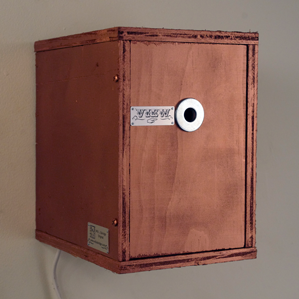 Moxes: The first one was made out of a cardboard box, a self-portrait polaroid, duct tape, a 40 watt light fixture, fishing line and a lighting gel. “Mox” is a made up word. It is a hybrid of “media” and “box”. It could also be short for “moxie”. They aren’t exactly shadow boxes and they aren’t exactly dioramas. I couldn’t figure out what to call them, so I made up the name. I made this first one around 1996. I was heavy into surrealism and mixed-media art with found objects like that of Joseph Cornell. However, I wasn’t really into shadow boxes. I felt they revealed too much all at once. I wanted to make something that inspired curiosity. Something that would encourage viewers to look deeper and stick around. It just hit me to enclose the box completely with just a small nickel-sized peep hole. This allows the viewer to explore on their own terms and possibly find some of the hidden gems inside.
Moxes: The first one was made out of a cardboard box, a self-portrait polaroid, duct tape, a 40 watt light fixture, fishing line and a lighting gel. “Mox” is a made up word. It is a hybrid of “media” and “box”. It could also be short for “moxie”. They aren’t exactly shadow boxes and they aren’t exactly dioramas. I couldn’t figure out what to call them, so I made up the name. I made this first one around 1996. I was heavy into surrealism and mixed-media art with found objects like that of Joseph Cornell. However, I wasn’t really into shadow boxes. I felt they revealed too much all at once. I wanted to make something that inspired curiosity. Something that would encourage viewers to look deeper and stick around. It just hit me to enclose the box completely with just a small nickel-sized peep hole. This allows the viewer to explore on their own terms and possibly find some of the hidden gems inside.
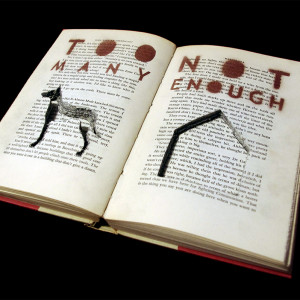 Carved Books: These started around 1998 while I was attending San Francisco Art Institute. There was a scene going around at the time that revolved around reduction and the space in between the space theme. It was hard to not get influenced by things that were going on. I was painting highly abstract and minimalist work and there was a big rise in alternative materials. Students were cutting squares out of drywall and then patching them up. Some were installing small partitions in random locations at the school – a lot of conceptual removal themes. I think I was intrigued by the reductive process and I just had the idea to take old, discarded books and start painstakingly removing sections with only a sharpened pencil. I like the idea of keeping a record or “evidence” as I like to call it. So I save everything from the creations. The paper shapes that are carved out of the pages, the pencils and their shavings from having to constantly sharpen them are all neatly saved. It is a very meditative process. It helps me gain focus. I recently toyed with carving animal shapes, but wasn’t happy with the end result. It seemed too obvious. Plus now you can just buy a laser cutter and cut out anything you want in a matter of minutes. So I decided to just stick to the geometric shapes and let the process speak.
Carved Books: These started around 1998 while I was attending San Francisco Art Institute. There was a scene going around at the time that revolved around reduction and the space in between the space theme. It was hard to not get influenced by things that were going on. I was painting highly abstract and minimalist work and there was a big rise in alternative materials. Students were cutting squares out of drywall and then patching them up. Some were installing small partitions in random locations at the school – a lot of conceptual removal themes. I think I was intrigued by the reductive process and I just had the idea to take old, discarded books and start painstakingly removing sections with only a sharpened pencil. I like the idea of keeping a record or “evidence” as I like to call it. So I save everything from the creations. The paper shapes that are carved out of the pages, the pencils and their shavings from having to constantly sharpen them are all neatly saved. It is a very meditative process. It helps me gain focus. I recently toyed with carving animal shapes, but wasn’t happy with the end result. It seemed too obvious. Plus now you can just buy a laser cutter and cut out anything you want in a matter of minutes. So I decided to just stick to the geometric shapes and let the process speak.
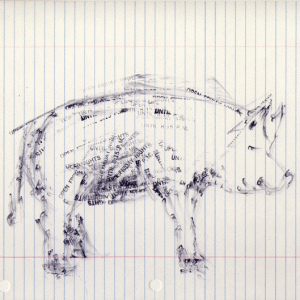 Stampings: The first stamping I did was in 1996 while living in Savannah, GA. It was a self-portrait on the back of a found blueprint. While walking to class one day, I had found an old stamp that says “Open Friday Nights Until 8:15 p.m.” I was intrigued with the stamp and wondered what kind of art could I make with this? If memory serves, I think the idea was an appropriation of Chuck Close’s fingerprint portraits. Most of them are created on notebook paper which can bring up the idea of education. I enjoy text as art and this particular text on the stamp explores notions of commodities and modern society as a whole. I expand on that by stamping construction vehicles and animals. The idea is loosely based on the dichotomy between survival and luxury. I still have the original stamp that I found, but it has worn down. I had to recently order a new one.
Stampings: The first stamping I did was in 1996 while living in Savannah, GA. It was a self-portrait on the back of a found blueprint. While walking to class one day, I had found an old stamp that says “Open Friday Nights Until 8:15 p.m.” I was intrigued with the stamp and wondered what kind of art could I make with this? If memory serves, I think the idea was an appropriation of Chuck Close’s fingerprint portraits. Most of them are created on notebook paper which can bring up the idea of education. I enjoy text as art and this particular text on the stamp explores notions of commodities and modern society as a whole. I expand on that by stamping construction vehicles and animals. The idea is loosely based on the dichotomy between survival and luxury. I still have the original stamp that I found, but it has worn down. I had to recently order a new one.
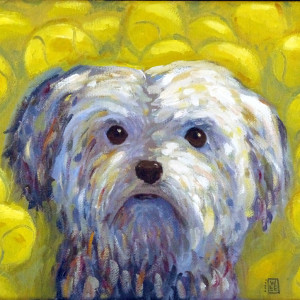 Pet Portraits: This is a collection of my main commission work. I started doing this work for people back in 1999. These were the beginnings of my foray into animal-based work. I still paint these and I love doing them. It keeps me in practice with the animal form and it allows me to meet new people and animals. Some are memorial portraits for animals that have passed on. While bittersweet, my clients always react with tears of joy.
Pet Portraits: This is a collection of my main commission work. I started doing this work for people back in 1999. These were the beginnings of my foray into animal-based work. I still paint these and I love doing them. It keeps me in practice with the animal form and it allows me to meet new people and animals. Some are memorial portraits for animals that have passed on. While bittersweet, my clients always react with tears of joy.
Any other projects in the works that you are looking forward to? I’m currently working on a big installation for our backyard, tentatively titled: “Bear Camp” I have been exploring more natural and less resource-heavy materials. I’m working with papier maché and ferro-cement. There will also be small oil paintings incorporated in the installation. I can’t reveal too much, but there will be a big bear, sound and projection. It will be the biggest installation I have done so far and I will be hosting a viewing party/reception/camp-over in October. I am very excited about it. I will also be hitting the road for a couple of art markets in the fall and winter.
EF: Where do you hope to see yourself in 10 years?
WE: Living within 2 hours of a coast on 3-5 acres of land with a sculpture and installation garden. I’ll hopefully have at least one international show (either group or solo) under my belt. I would love that. At least one piece purchased by a collecting museum. There will be rescue animals all around. My wife and I will be running a non-profit drive-inn theatre on the property, on the side. Making art every day of my life and eating donuts!
GENERAL/RANDOM Q’S
EF: What are the stories you like to tell in your artwork? What are the common themes/what are your inspirations?
WE: I like to convey a sense of appreciation to the audience, whether it be an animal, a landscape or an old house. These are all subjects that I have concentrated on and I think the running theme in all of my work through the years is an appreciation for the trials and tribulations that have brought us to where we are. What did it take to get that food on your plate? Who lived in that house? Who built that house? Where exactly is that landscape? So much goes into our modern conveniences and it’s such a fast-paced world out there, it’s important to slow down every now and again to think about the processes that are hidden or ignored by the general public and say “Thank You,” whoever “YOU” might be. I’m constantly inspired by nature, animals and animal behavior, obsolete technology and history in general.
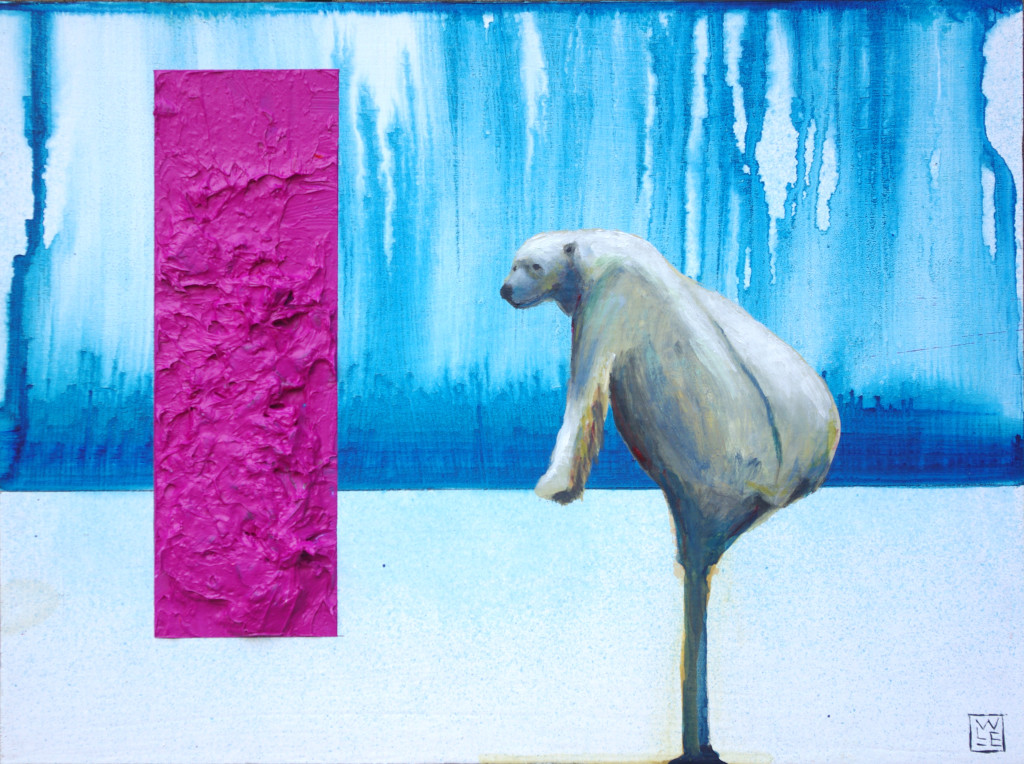
EF: Walk us through your creative process. How do you get from point A to finished product? How long does one piece of artwork usually take you?
WE: Most of my paintings take approximately two weeks. Many of my canvases and all of my wood panels are hand-built by me. I take pride in this process as it is vital to the integrity of the work as a material form. After the panel is constructed I apply three layers of gesso. When the gesso has dried the first thing I do is take my straight edge and draw a horizontal line on the painting. I don’t measure; I just do what feels right at the time. Using a spray bottle, I spray the lower half liberally. Then I mix a color and get a nice watered down flat brush, dragging it against the bottom of that horizontal line across the width of the painting. This allows drips to form. I’ll spray again, hitting the bottom of the paint stroke to help the drips and let the paint fade towards the bottom. This is the first layer. This dries completely for a day or two. Then I rotate the painting 180 degrees and do the same thing with a different color. I may do this two or three times with slightly different colors to build up atmosphere and color depth. Now the background is finished and I can start on an animal. I have a handful of animals I just love and keep in my repertoire. But sometimes I come across an article or a documentary about an animal that isn’t often seen in the context of art and that can ignite a spark. If it’s a new animal I haven’t painted before, I do a few sketches in my sketchbook from various angles as well as details like eyes, nose and feet. A lot of my reference material comes from my trips to non-profit animal and wildlife sanctuaries. This is very important as I do not want to patronize a commercial zoo or a circus that exploits animals solely for entertainment. So I do my research on the places I visit. Other references come from screen shots that I take of animal documentaries. This approach isn’t ideal for various reasons, but I make it work. Once I have the animal in mind, I’ll carefully paint a thin silhouette. I’ll then work with the paint while it’s wet, slowly pulling and pushing the lights and darks. If I decide to let a leg or body part drip, I’ll hit it with the spray bottle and control the drip by blowing or angling the painting to let gravity assist. I let that dry. I’ll then go back with thicker paint and start adding touches of color in an impressionistic way. I’m not shooting for photo-realism. I want the animal’s wildness and instinct to be represented with loose colors and texture. I will usually do a final third layer for the animal, hitting fine highlights of the fur and deep shadows like the pupils of the eyes and nose cavity. The last thing is the geometric shape. I take my right angle and measure out a rectangle. I mark it with a pencil and then mask it off with tape. Next I take my Pantone book and hold it up to the painting from about 5 feet away to see what color is going to work. Then I mix it up with impasto medium and apply the thick paint over the masked area with my palette knife. I love when I pull the tape off and reveal that crisp, clean edge. It’s a very satisfying way for me to finish off a painting.
EF: What have you learned about yourself through your artwork/projects?
WE: I have become a patient and self-disciplined artist; something I have achieved through experience over time. Working primarily with oils allows me to work in stages, which allows me to step back and reflect on the work in progress. I often sit in front of my work during these downtimes to contemplate. This slows me down and helps me not become frantic. It’s very meditative. Although I stay busy, I have been able to extend this approach into other areas of my life.
EF: Do you work on one project at a time until finished – OR – do you work on multiple projects simultaneously?
WE: I must have multiple projects going on at the same time. It can boil over at times, but I love it. I almost can’t work if I don’t have at least 5 paintings going, film or an installation project, and a sculpture to boot. I enjoy putting pressure on myself. It keeps me on my toes and I’m never bored, but it is not frantic; I don’t like frantic. I work in peaceful solitude in the studio. When I’m working on a piece, I am committed, in the zone and extremely focused on that one piece until I’ve done all I can for that painting at that time. Then I will move to another piece and work on it with the same intent, while the previous piece’s layer is drying, etc.
EF: Do you ever have the artist equivalent of “writers block?” How do you get past this so you can keep/finish creating?
WE: Yes, definitely. But the blocks are few and far between. I have a running list of stickies and notes of my ideas that come to me, but I usually keep a small notepad on me so I can immediately write them down. Most of the ideas are not grand, but writing them frees my mind. When I do have artist’s block, I just go back to the basic elements. If the piece is giving me a real hard time, I’ll put it away for a couple of weeks and then come back to it with fresh eyes. Sometimes I will set up a simple still life and focus on form, color and composition. A landscape painting is another way to step out of the conceptual block and focus on the elements. This way I am still practicing, but allowing my subconscious mind to work through whatever it needs to work through. Having a number of projects to work on at any one time helps.
EF: When you are not creating, what might one find you doing?
WE: Hiking, camping, tinkering on my 1953 Buick, playing drums in my metal-band, watching a good horror film or Miami Vice with my wife, snuggling with our dogs and cats, eating donuts…
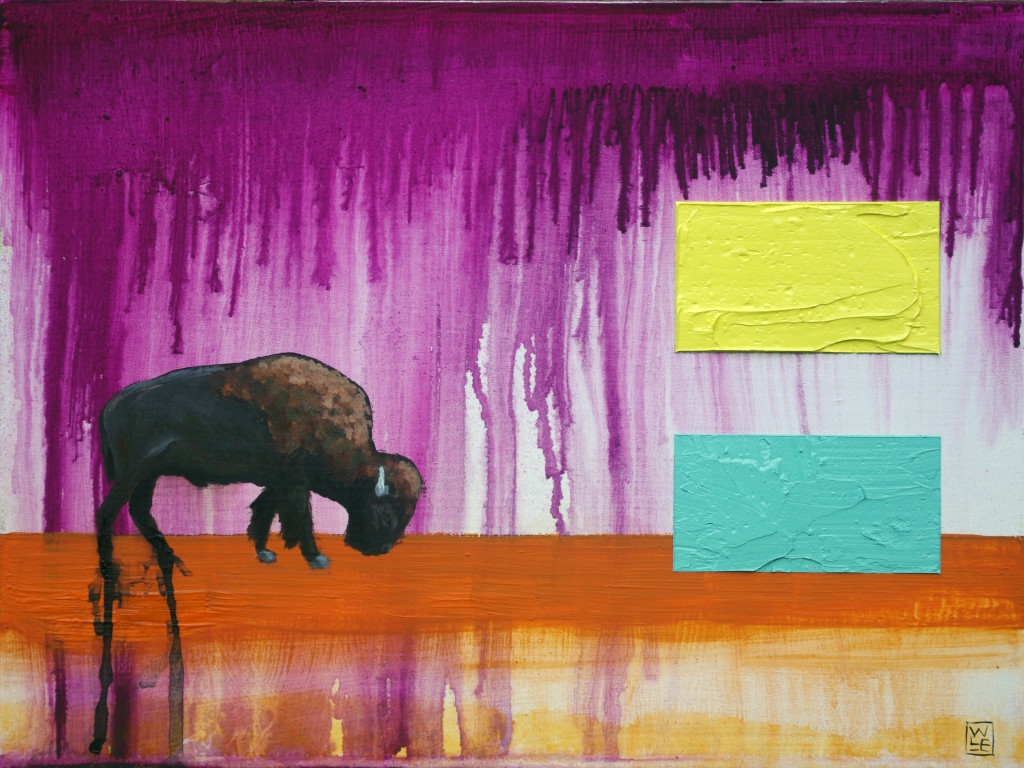
EF: If you had to pick one piece of your work to represent yourself as an artist, which would it be and why?
WE: “Wolf City” I worked so hard on this piece day and night. The experience and response was nothing shy of amazing. There was so much that went into it: film, sound, painting, and sculpture. It encompassed all my art-making loves. It was a true multimedia experience! At the reception, I sold all of the paintings and met a ton of great artists and art-lovers. Michael Stipe even stopped in and quietly admired (or judged) the installation for a few moments. Viewers were very receptive, engaged and asking great questions. The big wolf head is now in our backyard. My wife, Marie, told me she saw some birds fly up in through the opening in the bottom and make a nest which really pleased me.
EF: For whom do you create? Who is your audience?
WE: I create initially for myself. It is my therapy. But I also want to inspire questions about the plight of animals and nature without being depressing or literal. I would just like people to become increasingly aware. So I guess I create for anybody wanting to open their mind a bit. The majority of my audience tends to be animal-lovers and outdoor fans. My work also seems to attract ecologists, biologists, writers and environmentalists. Recently, after giving a presentation, an audience member identified himself as an ecologist and I thought he was going to discredit my work with some scientific research or obscure factual information. To the contrary, he was very complimentary and understood what I was getting at immediately. I do my best to get the facts and research, but there is always room to learn more.
EF: How do you promote your work? Do you seek out opportunities or do they come to you?
WE: I am pretty active on all the major social media outlets. This is my main source of promotion right now. Word of mouth has been good to me as well. I try to go above and beyond just selling a painting. I like to interact and engage people. As far as opportunities, I do seek them out. A handful have come to me, which is always flattering and validating, but I get really giddy when this happens. I think I have to make my life what I want it be, so I don’t wait for opportunities to find me.
EF: How do you continue to challenge yourself and grow as an artist?
WE: On a technical level, I’m always looking for new species to paint. New animals are always challenging, however, this keeps things fresh for me. I am a bit obsessed with David Attenborough and his documentaries. They often open up doors to animals I did not even know existed! On a philosophical level, I read a lot of research on animals, ecology and the environment. This often suggests challenges that might be addressed in a creative way. I’m also constantly trying to find ways to lessen my impact on the earth while still making my art. I evaluate my materials and my processes with much scrutiny. I use water-miscible oils using only water from our rain barrel as my medium and cleaner (no turpentine or paint thinners), FSC certified wood for my wood panels and hemp (when possible) for my canvases.
EF: Do you sell your artwork? If-so, where can we buy it? I do sell my work.
WE: The easiest and best place is through my website, www.willeskridge.com.
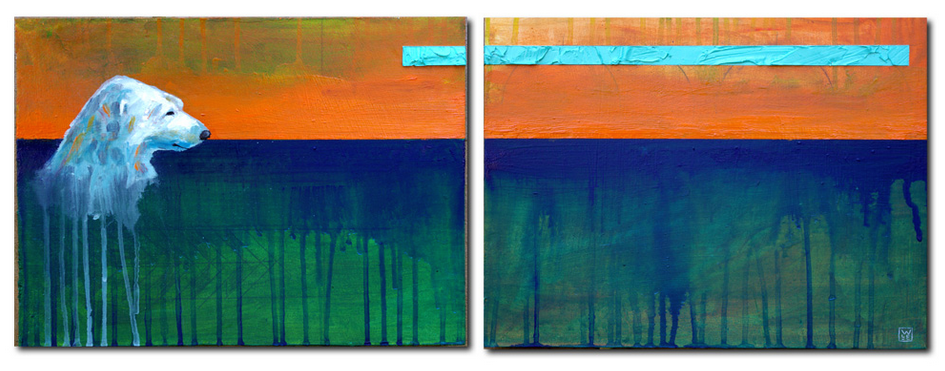
EF: What artists do you admire and why?
WE: Oh wow, there are so many! My dear friend, Nick Madden. He’s a dedicated artist working with kinetics, collage and mixed media material in Atlanta. He’s got the drive, skills and integrity and we always have excellent discussions. His approach is almost opposite of mine. I tend to over-plan while Nick just grabs a hammer, duct tape and some white-out and goes at it. New Orleans artist, John W. Fesken. He makes dark, mixed media pieces that are surreal, epic and cinematic, yet somehow they have a personal undertone. He is very approachable and a joy to talk with. Can’t leave out my photographer friends Sean Dunn and also Jillian Guarco. Sean is a superb black and white photographer and Jillian hits the surreal with polaroid transfers and collage work. My friends Hope Hilton and Cindy Jerrell, are outstanding artists as well. Hope does collaborative pieces, installations, writes and does a tremendous amount for the community here in Athens. Cindy does incredible collages and shadow boxes. She is also a kindred spirit artistically, as we have similar approaches to art and attitudes towards the art world. I admire any artist who has a positive vibe, nurtures their talent and has dedication or as my dad would say, “stick-to-itiveness”.
EF: Do you have a favorite piece of art (other than your own)?
WE: I would have to say, “Sunlight in an Empty Room” by Edward Hopper. It’s such a lovely, haunting piece. There are no people or possessions, just an empty room with sunlight from a window hitting a wall. It could be dusk or it could be dawn. The viewer gets the sense that someone has just moved out, and the painting is capturing that small moment of calm between the seasons. What all went on in that room before? What led to it being vacant? And what will its future be? For me, the painting conjures up feelings of rebirth and change – remembering the past while progressing towards the future. It is a wonderful piece and one of his last.
EF: What is the best piece of advice you have ever received?
WE: While attending S.V.A., I was back in North Carolina for Christmas break and I met with my previous professor, Clyde Fowler. I was complaining about all these repetitive core classes that I had already taken from him. He stopped me and said “There is never anything wrong with going back to the basics.” I was silenced immediately. I took this advice to heart. Going back to the basics is a great trouble-shooter…and not just in art. If a computer or car is acting up, just start with the basics and then expand on that. I use this advice every day.
EF: What is your favorite book?
WE: The Outsiders by S. E. Hinton
EF: What are you currently reading?
WE: I have a habit of reading multiple books at the same time. I am currently reading Eric Fischl’s biography, “Bad Boy: My Life On and Off the Canvas”. I just started “The Pit and No Other Stories” by my friend and author, Jordan Rothacker. I am also reading “The Life-Changing Magic of Tidying Up” by Marie Kondo.
EF: Do you have a favorite quote?
WE: “Getting angry doesn’t solve anything” – Grace Kelly
EF: Where can we see more?
WE: I have work showing at various local venues on a regular basis. I am also hitting the road for a few art festivals this fall. Viewers can always see my latest art through my website and on the social networks.